Panhead. Shovelhead. Knucklehead. Evo. 103, 107, 114… These might all sound like random words and numbers to the uninitiated, but for those that recognize the terminology, they know each of these as milestones in the evolution and lifespan of motors that have been featured in Harley-Davidson motorcycles. The history of engines can be broken down into about nine distinct eras dating back to the early 1900’s when the first 45-degree V-twin was rolled out, dubbed the “F-Head.”
The road leading to the present-day use of the 107, 114, 117, and Evolution motors has been a long and winding one, but each generation of engines has helped shape future engine changes and improve the technology, as well as keep Harley-Davidson on the leading edge of V-twin engine development. In the article below, we’ll dive into the history of Harley-Davidson’s engine development by era, and give a breakdown on how to help interpret the size of HD motors.
Table of Contents
The Journey of the Big Twin: A Timeline of Harley-Davidson Engines, by Generation
F-Head
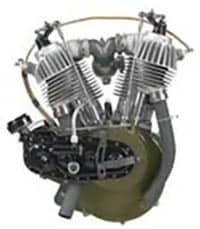
To better understand how Harley-Davidson arrived at the motors it uses in today’s lineup of motorcycles, let’s go back in time to when it all started over 100 years ago. That’s right – the first F-Head engine made its introduction beginning with 1911 model year motorcycles and was one of the earliest 45-degree V-twin engines used, with production lasting until 1929. The F-head engines were inlet over exhaust (IOE) motors that came in either 61 or 74 cubic inch versions, with either 1000cc or 1210cc options. Harley-Davidson would continue to use the 45-degree V-twin platform for future engines for the next several decades and beyond, and the F-Head would eventually be replaced by the Flathead engine beginning in 1929, just months before the Great Depression took hold.
Flathead
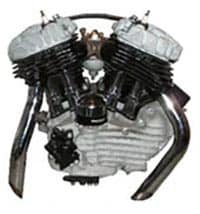
The Flathead was launched as a 45 cubic inch motor initially; the 74 cubic inch V model appeared in 1930 and was intended to compete with a rival, which was the 74 cubic inches Indian Chief. The Flathead engines were available as 737cc and 1212cc options, with newer U series motors replacing the previous V models starting in 1937, and a UH series offering an 80 cubic inch motor from 1937 to 1941. The Flathead remained in production until the 1970’s, notably appearing as the power plant for three-wheeled Servi-Car delivery vehicles during that time.
Knucklehead

In 1936, the Knucklehead engine was launched with its signature rocker boxes and was the first Harley-Davidson motor to feature overhead valves and a newer oil lubrication system. The Knucklehead was available in 61 and 74 cubic inch versions and ranged from 983 to 1212cc. Production lasted through 1947 when it was replaced by a similar-sized Panhead engine in 1948. The Panhead engines were a favorite among Harley-Davidson enthusiasts and were the first HD motor with hydraulic valve lifters and aluminum heads.
Shovelhead

The Shovelhead emerged in 1966 as a successor to the Panhead, with larger 74 and 82 cubic inch variations that offered 1212-1343cc iterations. The larger motors in this era emerged as a response to the increasing weight of motorcycles, and put more power to the wheel than previous engines to compensate for the added weight. During the Shovelhead era, in 1969, AMF took over production of Harley-Davidson motorcycles; while this ownership kept the company financially afloat during the boom of Japanese motorcycle sales occurring in the 1960s and 1970s, it also marked an era of diminished manufacturing quality and reduced pride of ownership. The AMF era ended in 1981 when Harley-Davidson was able to buy back ownership from AMF.
Evolution

The Shovelhead remained in production through the acquisition and sale of Harley-Davidson from AMF until 1984, before passing the torch to the appropriately-named 80ci Evolution motor that same year. The Evolution motor was used from 1984 to 1999 and appeared at the same time that the company underwent a rebranding revival to distance itself from the AMF era and rekindle the pride of ownership and community it had lost in the years prior. The 1343cc Evolution (or “Evo”) motor ran smoother and cooler than previous engines, and while it was more technologically advanced than earlier motors, it had a notable issue with oil circulation.
Twin Cam
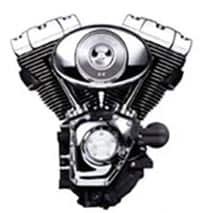
In 1999, the Twin Cam era began with an 88ci engine and later included 93, 103, and 110 cubic inch variants, as well as the 88B motor, found specifically in Softail models. The Twin Cam featured an improved internal oil pump to resolve the oil issues seen in the Evo motors, a dual-coil ignition system as well as the option for either a carbureted or fuel-injected motor. The Twin Cam motors were more powerful than Evo motors, with 1442 to 1687cc motors producing higher horsepower and torque specs than its Evo predecessor.
Revolution
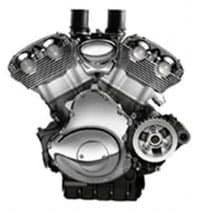
A different type of V-twin emerged in 2001 with the Revolution motors. These engines – which were the stock option for V-Rods beginning in 2001 – were 60-degree V-twins, a departure from the many generations of 45-degree V-twins that came before it. The water-cooled Revolution engines began as a 69ci engine before being super-sized to 76ci starting in 2008. These engines were born as a result of a business partnership between Porsche and Harley-Davidson to construct a counter-balanced engine that could help Harley-Davidson compete against the increased sales of Japanese sportbikes and metric cruiser motorcycles.
Milwaukee-Eight Wafflehead

The engine found in present-day Harley-Davidson motorcycles is referred to as the “Big Twin” Milwaukee-Eight Wafflehead, named for its valve covers distinctly resembling waffle irons. The Wafflehead began hitting dealerships in 2017 in both 107ci and 114ci versions, and a 117ci edition rolled out in CVO models beginning in 2018. These engines were available as air-cooled (107ci only for the 2017 model year, and Softail models beginning in 2018) and water-cooled for both 107ci and 114ci versions, with engines ranging from 1746cc to 1923cc. In contrast to the Revolution motor, the Wafflehead returned back to the 45-degree V-twin setup and was counter-balanced to improve ride experience and reduce vibration.
How to Interpret Engine Sizes
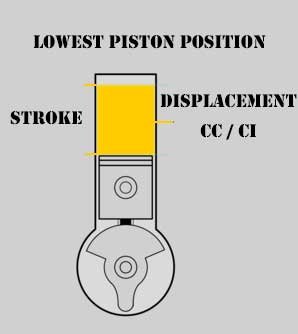
Now that we’re caught up on the history of engines found in Harley-Davidson motorcycles, you might be wondering how to tell what motor is which – with all of the variants and numbers and versions, it can be challenging to keep it all straight.
Older motorcycle engines were generally referred to by the monikers, such as Knucklehead or Shovelhead, and not necessarily the engine size. Most Harley-Davidsons manufactured from 1936 (beginning of the Knucklehead generation) to 1965 (end of the Panhead generation) came in 61 and 74 cubic inch versions ranging from 1000 to 1212 cc editions. The 74 ci would survive through the end of the Shovelhead era, which simultaneously introduced the 80 ci motors that would last through the Evolution era. The Twin Cam 88 introduced the 88ci motor in 1999, and the Twin Cam 95 became available the following year. This ushered in the era of numeric engines we see referenced in non-vintage motorcycles.
For modern motorcycles, the easiest way to start interpreting the engine size is to consider the size of the motor in cubic inches. Most newer engines that are 96, 103, 110, 114, or 117 cubic inches are generally referred to numerically as their cubic inch size, such as just “103,” “114,” and so on. These motors will usually have corresponding badging on the air intake that matches the cubic inch size of the motor. When scaling from smallest to largest, there is a chronological sequence to the sizing, and one can safely assume the 96 motor is an older motor while the 117 motor is newer. (One thing to take note of: while the current generation of engines is technically referred to as the Wafflehead, it is colloquially known as either a 107 or 114 and not necessarily by the Wafflehead namesake.)
Current generation Sportsters, on the other hand, aren’t typically referred to by only the cubic inch measurement of their motor. Despite having two options for engine size, at 883cc and 1202 cc, you will hear them referred to with the Sportster identifier attached to their size such as “Sportster 883” and “Sportster 1200.”
To add to the complexity, there are some additional details around the larger, non-Sportster motors you should be aware of. The CVO motors started as 1800cc Twin Cam 110 engines and graduated to a 114 motor for 2017 models before settling in as a 117 motor for CVO motorcycles manufactured since 2018.
It’s a lot of info and minor details to keep straight, but thankfully, here’s a handy chart to help keep your head from spinning.
Harley-Davidson Engine Size Chart
| Engine Name | Volume (in cubic inches) | Volume (in cubic cm) |
|---|---|---|
| F-Head | 61 ci and 74 ci | 1000cc and 1210cc |
| Flathead | 45 ci and 74 ci | 737cc and 1212cc |
| Knucklehead | 61 ci and 74 ci | 983cc and 1212cc |
| Panhead | 61 ci and 74 ci | 983cc and 1200cc |
| Shovelhead | 74 ci and 80 ci | 1212cc and 1343cc |
| Evolution | 80 ci | 1343cc |
| Twin Cam 88 | 88 ci | 1442cc |
| Twin Cam 88B (counterbalanced) | 88 ci | 1442cc |
| Twin Cam 95 | 95 ci | 1550cc |
| Twin Cam 96 | 96 ci | 1584cc |
| Twin Cam 103 | 103 ci | 1690cc |
| Twin Cam 110 | 110 ci | 1800cc |
| Milwaukee-Eight 107 (Standard) | 107 ci | 1746cc |
| Milwaukee-Eight 107 (Twin-Cooled) | 107 ci | 1746cc |
| Milwaukee-Eight 114 (Twin-Cooled) | 114 ci | 1868cc |
| Milwaukee-Eight 117 (Twin-Cooled) | 117 ci | 1923cc |
| Evolution (Sportster/Small V-Twin) | 54 ci and 73 ci | 883cc and 1200cc |
In The Future…
Only time will tell what changes Harley-Davidson will make to their engines, and what new technology and developments will occur with these changes. They have already begun to branch out in recent years with the recently released LiveWire electric motor, along with the Revolution Max 60-degree V-twin featured in the Pan America. However, the classic 45-degree V-twin will forever remain a staple to the Harley-Davidson brand, and hopefully, the future revisions made to the engine will continue to build upon its legacy.

I guess all these articles just plagiarize one another, as they all neglect to even mention the Ironhead, Sportster’s v-twin from ’57 until ’85.
you musnt know how to use a search engine, because there are articles that include the sportster engines
fat rob you legend
I didn’t see anything mentioned on the Pan either – one of the motor companies most iconic engines – pathetic….
May want to look again. Plain as day